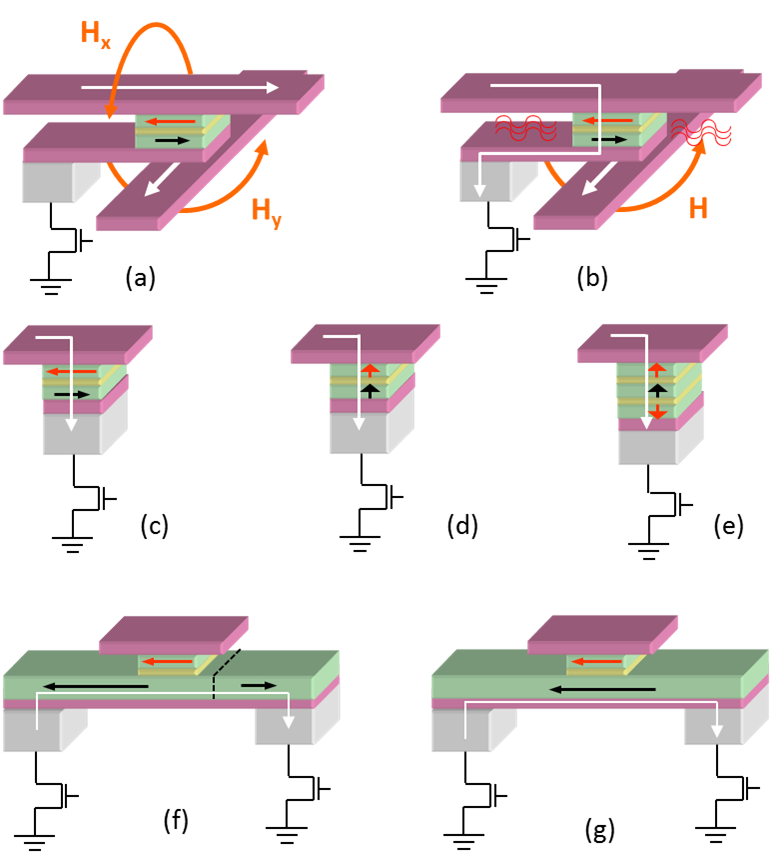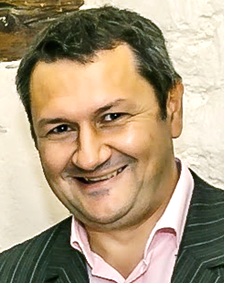Thematic overview
Magnetic Random Access Memories (MRAM) is a non-volatile memory technology, where information is stored by the magnetization direction of magnetic electrodes, very similar to computer hard-disk drives. The goal for MRAM memory is to simultaneously achieve high-speed read/write times, high density and unlimited cycling compared to other existing and emerging technologies.
Our group is developing advanced MRAM cell concepts patented at Spintec. The concepts are based on the use of temperature to reduce power consumption and increase the stability of the stored information. These ideas go beyond the conventional MRAM approach. The naturally occurring temperature increase during the write step is not lost, but is instead used to achieve the seemingly opposing goal of lowering the power consumption and increasing the thermal stability in the operating temperature range. Our group fosters young and experienced researchers developing/applying their expertise in the field of MRAM.

Questions to be addressed
Our main research axis is to use the naturally occurring temperature increase during the write step, when a current flows through the magnetic tunnel junction. The heating is used to go above a temperature threshold, making it possible to write the storage layer magnetization. This principle has been applied to in-plane magnetization cells using a storage layer pinned by an anti-ferromagnet and recently to perpendicular anisotropy cells. Our group’s goal is to demonstrate the proof-of-concept and then improve MRAM cell properties.
Our work involves the development of magnetic material systems, nano-fabrication (20-200nm cells), characterization of devices (magnetic & electrical) and simulation of the device behavior. Our activity in these vast fields is as follows;: On materials research, we are developing magnetic tunnel junctions with in-plane and perpendicular magnetic anisotropy. New electrode stacks having the material properties required by each specific concept need to be integrated in magnetic tunnel junctions, while achieving high levels of TMR signal. For the characterization of each concept we determine the write window parameters in terms of magnetic field, power consumption and magnetization reversal dynamics. Macrospin and micromagnetic simulation provide a better physical understanding of the system properties and the possibilities for optimization.
Projects
ANR EXCALYB – Perpendicular Anisotropy Materials for High-Density Non-volatile Magnetic Memory Cells
Crocus R&D – Thermally assisted MRAM
Samsung SGMI
Partners
Crocus Technology
Institut Néel
SP2M/NM
SAMSUNG
Applied Materials
SINGULUS
Recent news
- Bernard DIENY receives the IEEE Carrier Achievement Award [November 01st, 2018]
Bernard DIENY receives the 2018 IEEE Carrier Achievement Award for contributions to spintronics applications including spin-valves and MRAMs and for strengthening the relationship between magnetics and microelectronics communities. The Award will be handed out at ... - Masters thesis projects for Spring 2019 [October 10th, 2018]
You find here the list of proposals for Master-2 internships to take place during Spring 2019. In most cases, these internships are intended to be suitable for a longer-term PhD work. Interested Master-1 students are ... - PhD thesis defense: Ultimate scalability of STT MRAM: storage layer with perpendicular shape anisotropy [August 26th, 2018]
On Friday 31 Aug, Nicolas PERRISSIN defends his PhD at 14h00 in room M001 of Grenoble INP – Phelma – 3 Parvis Louis Néel – Grenoble. Keywords: STT MRAM, perpendicular shape anisotropy, Ultimate scalability Most of the ... - Sub-10nm thermally stable Perpendicular Shape Anisotropy magnetic memory [August 24th, 2018]
A new concept of thermally stable and electrically switchable Spin Transfer Torque Magnetic Random Access Memory (STT-MRAM) scalable to diameter down to 4nm was proposed and demonstrated. By dramatically increasing the thickness of the storage ... - Editor – Topical issue in MRS bulletin: Advanced memory—Materials for a new era of information technology [April 10th, 2018]
Bernard Dieny (from Spintec) and Cheol Seong Hwang are Guest Editors for a topical issue of the MRS Bulletin in May 2018, dedicated to Advanced memory—Materials for a new era of information technology. View online: DOI: ...

SOUSA Ricardo
ricardo.sousa@cea.fr

BALTZ Vincent
vincent.baltz@cea.fr

PREJBEANU Lucian
lucian.prejbeanu@cea.fr

DIENY Bernard
bernard.dieny@cea.fr





